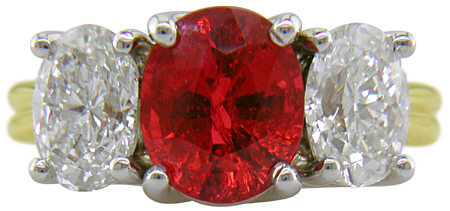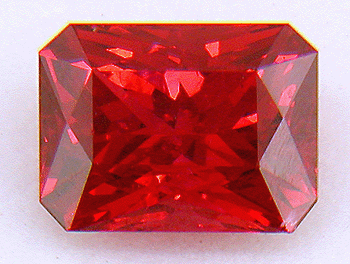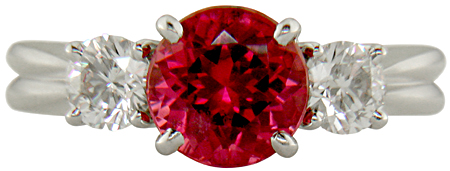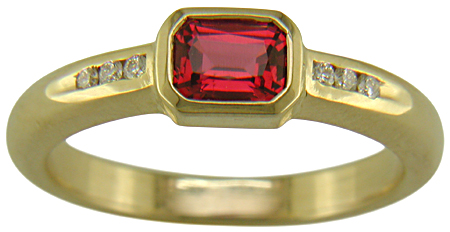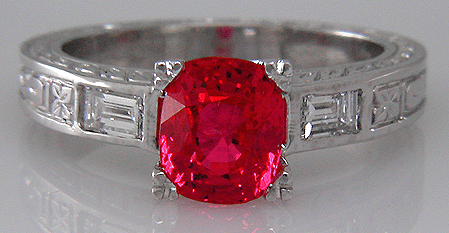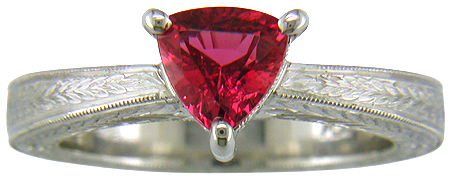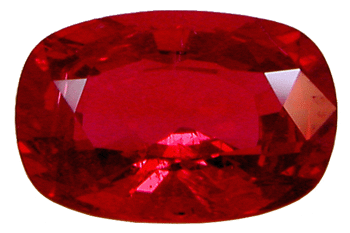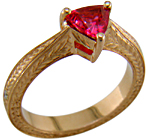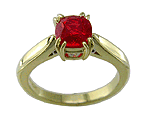The Passion and Fire of Red SpinelBy Judith Anderson |
|
A fiery red spinel set with
diamonds
in a custom engagement ring. Natural spinel is truly an underappreciated gem. It is one of my favorite gemstones so naturally I have created many designs featuring this incredible gem. I also maintain a large inventory of beautiful natural spinels waiting for the next custom project. I love working with gemstones that have charisma; gems with sparkling personalities that reach out and grab you. Red spinel is one of those gems that immediately captures your eye and draws you into an enchanting sea of rich red hues. I also love gemstones that have a little mystery in their past; gems that have a history that adds to their beauty and romance. Once again, red spinel is just such a gemstone! 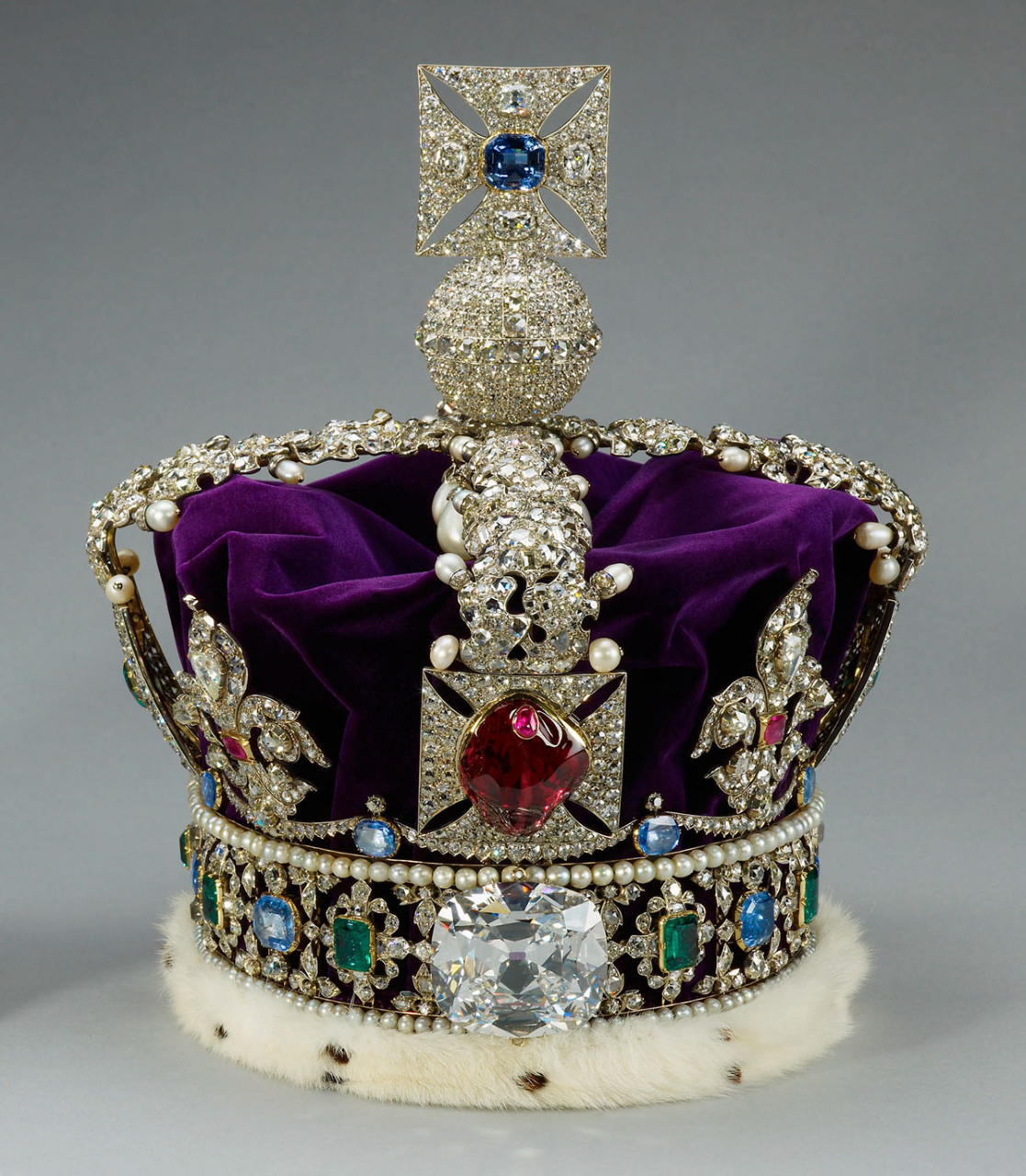 The British Imperial State Crown with the Black Prince Ruby
Throughout the centuries vibrant red spinels have been mistaken
for more precious rubies. In fact, the British Crown
Jewels were once thought to feature a large ruby nicknamed "The
Black Prince Ruby." Then in the late 19th century this
spectacular red gem, as well as several other dazzlers in the
Crown Jewels, was identified as a red spinel. The Black Prince Ruby is one of the most famous red spinels with a history dating back to 1366 AD. It is currently mounted on the front of Britain's Imperial State Crown and resides in the Tower of London. By the way, that large old mine-cut colorless bauble beneath the Black Prince Ruby is none other than the Cullinan II diamond which has a rich history all its own. The vibrant color and mesmerizing clarity of fine red spinels make it an ideal gemstone for a variety of ring designs either as a center stone or accent stones. I have been lucky to work with a number of clients over the years who wished to create a ring or other jewel featuring an exceptional red spinel. Here are a few of the rings we created ... Spinels are cut in many
different shapes with the cushion-cut being the most
commonly seen. In fact, most spinels cut near the
mines in Myanmar and Bangkok have very deep pavilions (the
bottom half of the stone) due to the cutter's attempt to
retain as much weight as possible from the rough
crystal. Round, emerald and radiant-cuts are less
often seen and usually have been re-cut by a master
lapidarist.
Even though emerald- and
radiant-cut red spinels are less often seen, I work with
several gem cutters who specialize in these rarer
stones. I love these unusual cuts and have enjoyed
creating many rings with these exciting gemstones, like the
emerald-cut spinel set the the Tingle ring pictured above
Art Deco designs are a great way to feature vibrant red and pink flame spinels. Here is an example of a cushion-cut flame spinel that we featured in a striking platinum Art Deco design. The cool white of the platinum and brilliant sparkle of the side diamonds are the perfect accent to the mesmerizing flame spinel If the above red spinel rings have aroused a passion in you for fiery gemstones, please check out our Red Spinel Design Gallery and other fine jewelry galleries. I am always happy to chat about beautiful gems and new custom design projects. After all, I love custom creating jewelry with gemstones that sizzle and pop! I can be reached at judi@jewelryexpert.com or (603) 624-8672. A Little More For Gemology Geeks Spinel is a natural gemstone that crystallizes in the cubic system (like diamonds). There are many great sources of natural spinel such as Sri Lanka, Afghanistan, Vietnam, Tanzania, Kenya and Madagascar. A key source of the finest quality red spinels are the Mogok mines in Myanmar, which, coincidentally, is also a source of fine quality rubies. Natural spinels also occur in most colors of a rainbow ... including flaming orange pink, cobalt blue, black, lavender and green. In addition to red spinels historically being mistaken for rubies, natural spinel also has an imitator. Since the mid 1800s synthetic spinels have been created by the flux and flame fusion methods. Significantly less valuable than natural spinels, these manufactured stones became commercially available in the 1920s and were often offered as a substitute for more costly sapphires, aquamarines, rubies and alexandrites. The colorful "gems" set in class rings and mother's rings are most often glass or synthetic spinel. Fortunately for consumers, experienced gemologists like myself can readily identify natural versus synthetic spinels. When purchasing any gemstone, including fine red spinel, it is important to work with a knowledgeable, reputable expert. |
| |
||
| | Bijoux Library | Jewelry Galleries | What's New! | | Bijoux Home Page | About Us | Services We Offer | Site Map | If you have any questions, suggestions or comments, please give us a call (603 624-8672) or send us an email.
|
||
|
|
||

